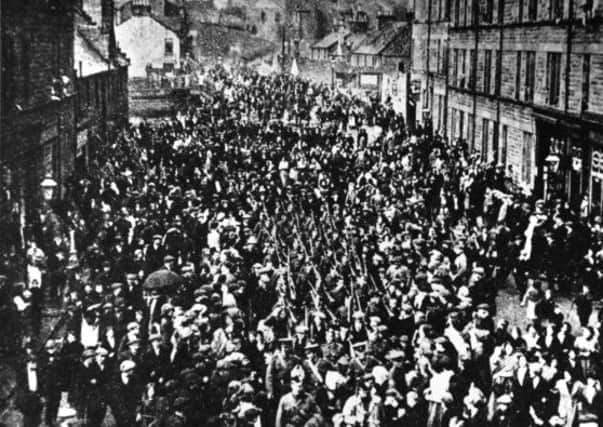Never to be forgotten - World War One centenary


It ravaged almost every end of the world and left visible scars across the European landscape.
In the end, as many as 19 million people lost their lives in just over four years of warfare.
Advertisement
Hide AdAdvertisement
Hide AdAlmost one million Britons died, in what was the single most brutal conflict to date.
The effect of the war was felt all over the country, in all walks of life.
East Dunbartonshire — which at the time included the northern corridor villages of Chryston, Stepps, Moodiesburn, Gartcosh and Muirhead — felt the loss of almost 1,000 souls.
Nearly half of those East Dunbartonshire residents who died were from Kirkintilloch.
Advertisement
Hide AdAdvertisement
Hide AdThe impact of the war was felt in both family life and the every day experiences of those on home soil.
One of the biggest results of the war was an absence of skilled workers which led to a local labour crisis.
On March 24, 1915, an article published in the Kirkintilloch Herald read: “...the effect of so many men being withdrawn from industries by the war, and of the great demand upon many trades to furnish munitions of war, is making itself still further felt in the Labour Market.
“Trades affected by war contracts continue to be very busy, with much overtime. The scarcity of agricultural labour is becoming accentuated.”
Advertisement
Hide AdAdvertisement
Hide AdThe total war effort became more prominent and more workers were ‘channelled’ into manufacturing industries.
It was reported that by 1916, some 200 people from Kirkintilloch travelled into Glasgow each day to work in the munitions factories.
There was a deficit of doctors in the town, and water shortages were reported due to a lack of skilled plumbers.
On more than one occasion, the town council requested the release of a plumber from the army.
Advertisement
Hide AdAdvertisement
Hide AdA food shortage meant that some soldiers were released from duty to help in the fields.
An article in the Herald, dated March 14, 1917, said: “At several farms in the parish the farmers have had to call upon the military to assist in the undertaking of agricultural work.”
When soldiers were no longer able to support the farmers, school children were drafted in to help.
News from the front was slow and inaccurate, and some families were subjected to despair by false information.
Advertisement
Hide AdAdvertisement
Hide AdIn 1914, Malcolm McLean was informed that his son Robert was killed in action on September 24.
Yet, on the same day, Mr McLean received a letter from Robert dated after the 24th.
Indeed, Private Robert McLean was one of the first to sign up for duty and was one of the few members of the 1st Battalion who made it home.
Correspondence played a major role in morale for both troops and those left behind. Home-based soldiers often wrote letters to their families and to the Herald for publication.
Advertisement
Hide AdAdvertisement
Hide AdOn March 24, 1915, the Herald printed a letter from Mr W Murray Smith, the headmaster of Milton School.
He was serving as a Sgt. in the 9th Battalion of the Argyll and Sutherland Highlanders – also known as the Dunbartonshire Territorials.
It said: “The 9th Argylls are known to be the best territorial battalion.
“They are proud to be in the same brigade as the 1st Argylls, the 1st Royal Scots, 2nd Gloucesters, 2nd Camerons and 9th Royal Scots.
Advertisement
Hide AdAdvertisement
Hide Ad“The brigade is composed of six battalions instead of the usual four. This is because of the terrible wastage in modern fighting. In a single day, a battalion may be reduced to skeleton strength.”
Sgt. Smith added: “We were sent into the trenches on Monday, and as usual the B Company, which comprises the Kirkintilloch and Milngavie Companies, were sent first to show the stuff the battalion is made of.”
Upon returning from leave, Second Lt. Warr wrote: “No newspaper description of ruined Belgium can describe the utter terribleness and the ghastly reality.
“The roads are torn and blown up be shells; each village is worse than another – uninhabited, crumbling, smashed to atoms.”
He added: “No birds sing in this region of death.”
Advertisement
Hide AdAdvertisement
Hide AdMany local families were completely torn apart by the war. Some never saw their loved ones again.
The Shaw family in Kirkintilloch saw all three sons leave home to fight throughout Europe and the Middle-East.
Eldest brother John served in Mesopotamia — modern day Iraq — and returned home after the conflict.
However, one of this brothers was seriously injured while the other was killed in action.
Advertisement
Hide AdAdvertisement
Hide AdLouis Shaw, who had worked with James Rae Bakers in Kirkintilloch, was left permanently scarred while fighting with the Royal Scots in France. Yet, he survived his injuries, returned home and died at the age of 80.
Youngest brother Norman, however, was not as fortunate.
While serving as a Lance Corporal in the 10th Battalion of the Argyll and Sutherland Highlanders, Norman was killed in action, aged just 19.
He is remembered on the Arras Memorial in France.
After hostilities finally ended in November 1918, there were a number of war memorials erected to pay homage to those who died in the war.
Kirkintilloch, Lennoxtown, Twechar, Torrance, Bishopbriggs, Baldernock and Auchinarn all built their own local tributes.
Advertisement
Hide AdAdvertisement
Hide AdMilngavie and Bearsden have also done so along with others in Stepps, Chryston and Gartcosh.
The Herald would like to thank EDLC Archives and Local Studies at William Patrick Library, Kirkintilloch, for their help with this feature.